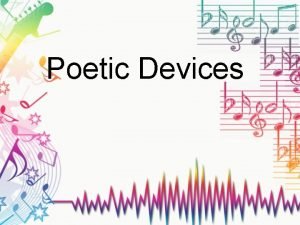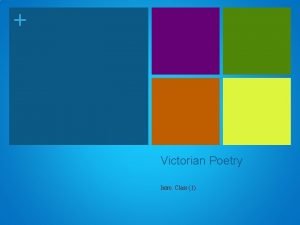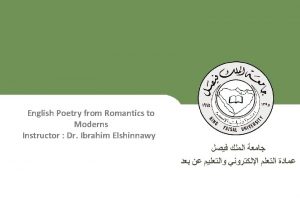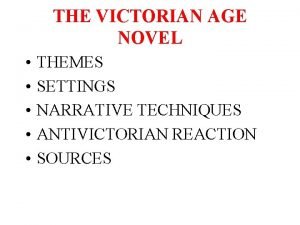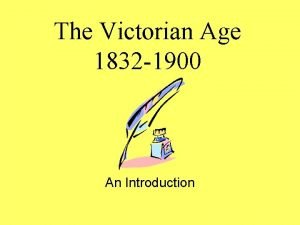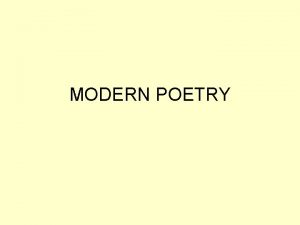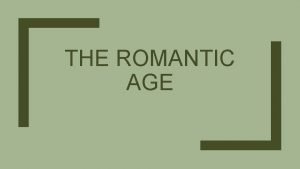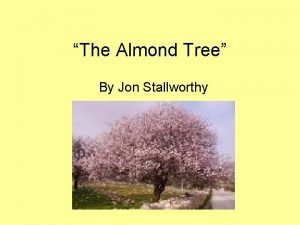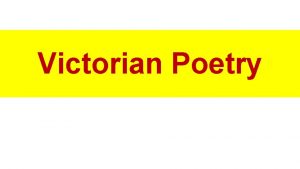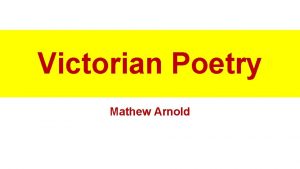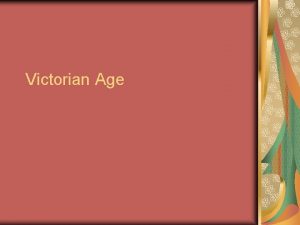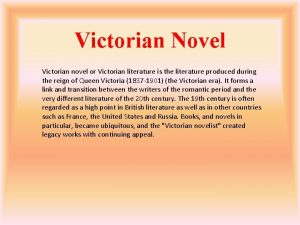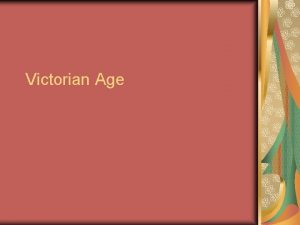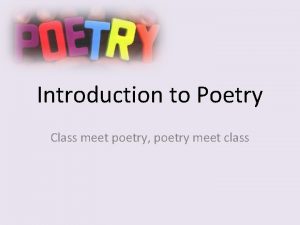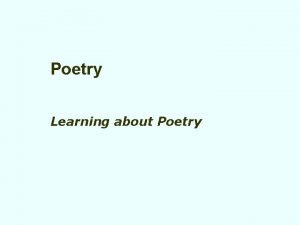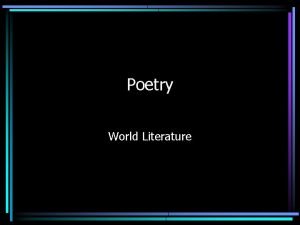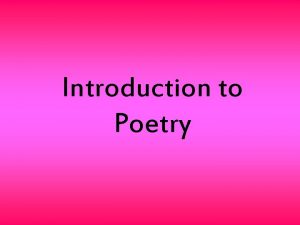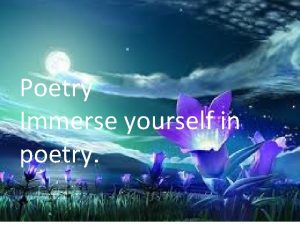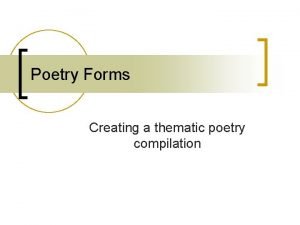Victorian Poetry Intro Class 1 n The Victorian
























- Slides: 24

+ Victorian Poetry Intro. Class (1)


+ n The Victorian era of British history was the period of Queen Victoria's reign from 20 June 1837 until her death on 22 January 1901. It was a long period of prosperity, refined sensibilities and national self-confidence for Britain. Some scholars date the beginning of the period in terms of sensibilities and political concerns to the passage of the Reform Act 1832. The era was preceded by the Georgian period and followed by the Edwardian period. The latter half of the Victorian age roughly coincided with the first portion of the Belle Époque era of continental Europe and the Gilded Age of the United States.

+ The Louth-London Royal Mail travelling by train from Peterborough East, 1845

+ The railways changed communications and society dramatically

+ By 1878, an increasingly famous Darwin had suffered years of illness.

+ In mid-July 1837 Darwin started his "B" notebook on Transmutation of Species, and on page 36 wrote "I think" above his first evolutionary tree.

+ Glasgow slum in 1871


+ Part of Charles Booth's poverty map showing the Old Nichol, a slum in the East End of London. Published 1889 in Life and Labour of the People in London. The red areas are "middle class, well-to-do", light blue areas are "poor, 18 s to 21 s a week for a moderate family", dark blue areas are "very poor, casual, chronic want", and black areas are the "lowest class. . . occasional labourers, street sellers, loafers, criminals and semi-criminals".

+ Working class life in Victorian Wetherby, West Yorkshire

+ Girl pulling a coal tub in mine. From official report of the parliamentary commission in the mid 19 th century.

+ The 1843 launch of the Great Britain, the revolutionary ship of Isambard Kingdom Brunel

+ The defence of Rorke's Drift during the Anglo-Zulu War of 1879

+ The last stand of the survivors of Her Majesty's 44 th Foot at Gandamak, Afghanistan

+ 'Rustic Civility' by William Collins RA, oil on panel, England, 1833, Museum no. FA. 27

+ 'The Governess' by Richard Redgrave RA, oil on canvas, Great Britain, 1844, Museum no. FA. 168

+ 'An Anxious Hour' by Alexander Farmer, oil on panel, England, 1865, Museum no. 541 -1905

+ 'The Stonebreaker and His Daughter' by Sir Edwin Henry Landseer RA, 1830, Museum no. 508 -1882

+ 'Contrary Winds' by Thomas Webster RA, oil on panel, Great Britain, 1843, Museum no. FA. 223

+ Intellectual and spiritual doubt: n Victorian poetry is self-defining: poetry written during the reign of Queen Victoria (1837 -1901). But the dates of Victoria's reign also seem to mark out a consistent sensibility in poetry. Victorian poets were heirs to the Romantics, and many of the generalizations about Romantic poetry still apply: distrust of organized religion, skepticism, interest in the occult and the mysterious. Yet where Romantic poets made a leap of faith to assert that the received image of God did not exist, Victorian poets were more likely to have a scientific conviction of God's absence ("Dover Beach" by Matthew Arnold is the great Victorian example). Such brooding skepticism informs the work of Tennyson, Arnold, Robert Browning and others

+ Skepticism: n The late-Romantic / early-Victorian poet Thomas Hood is here as a transitional figure; his famous poem "I Remember, I Remember" catches a note of nostalgic regret that carries through English poetry all the way to the 1890 s, and is not typical of the great energy of the "High Romantics. ”

+ Growing Social Consciousness & High Moral Tone: n Recurrent themes include childhood, the plight of women, rejected love, poverty and old age. In the Victorian period, artists and writers appealed in a very direct and emotive way to their audiences. Literature was intended to involve their audience in the way that films do today. But art and literature were not just for entertainment. Many artists, such as writers Charles Dickens and Charles Kingsley, had a reforming mission. They set out to evoke compassion and sympathy in the public and bring about a humanitarian response to the evils they saw in their society. Paintings and novels provided examples of good and bad behaviour, supplying ideal characters to be imitated and showing the grievous effects of not following society's rules.

+ Nationalism: Britain – first great modern industrial nation
 Louis xvi period floral design
Louis xvi period floral design Floral design timeline
Floral design timeline Introduction to poetry סיכום
Introduction to poetry סיכום Intro
Intro Victorian love poetry
Victorian love poetry Victorian poetry characteristics
Victorian poetry characteristics Victorian age theme
Victorian age theme Introduction to the victorian age
Introduction to the victorian age Characteristics of victorian fiction
Characteristics of victorian fiction Neoclassical and romantic poetry
Neoclassical and romantic poetry Traditional poetry vs modern poetry
Traditional poetry vs modern poetry Narrative poems by shel silverstein
Narrative poems by shel silverstein Augustan poetry vs romantic poetry
Augustan poetry vs romantic poetry The almond tree poem
The almond tree poem Hình ảnh bộ gõ cơ thể búng tay
Hình ảnh bộ gõ cơ thể búng tay Bổ thể
Bổ thể Tỉ lệ cơ thể trẻ em
Tỉ lệ cơ thể trẻ em Voi kéo gỗ như thế nào
Voi kéo gỗ như thế nào Thang điểm glasgow
Thang điểm glasgow Chúa yêu trần thế alleluia
Chúa yêu trần thế alleluia Các môn thể thao bắt đầu bằng tiếng nhảy
Các môn thể thao bắt đầu bằng tiếng nhảy Thế nào là hệ số cao nhất
Thế nào là hệ số cao nhất Các châu lục và đại dương trên thế giới
Các châu lục và đại dương trên thế giới Công thức tính độ biến thiên đông lượng
Công thức tính độ biến thiên đông lượng


